child lock MERCEDES-BENZ GL SUV 2012 Owners Manual
[x] Cancel search | Manufacturer: MERCEDES-BENZ, Model Year: 2012, Model line: GL SUV, Model: MERCEDES-BENZ GL SUV 2012Pages: 441, PDF Size: 10.66 MB
Page 10 of 441
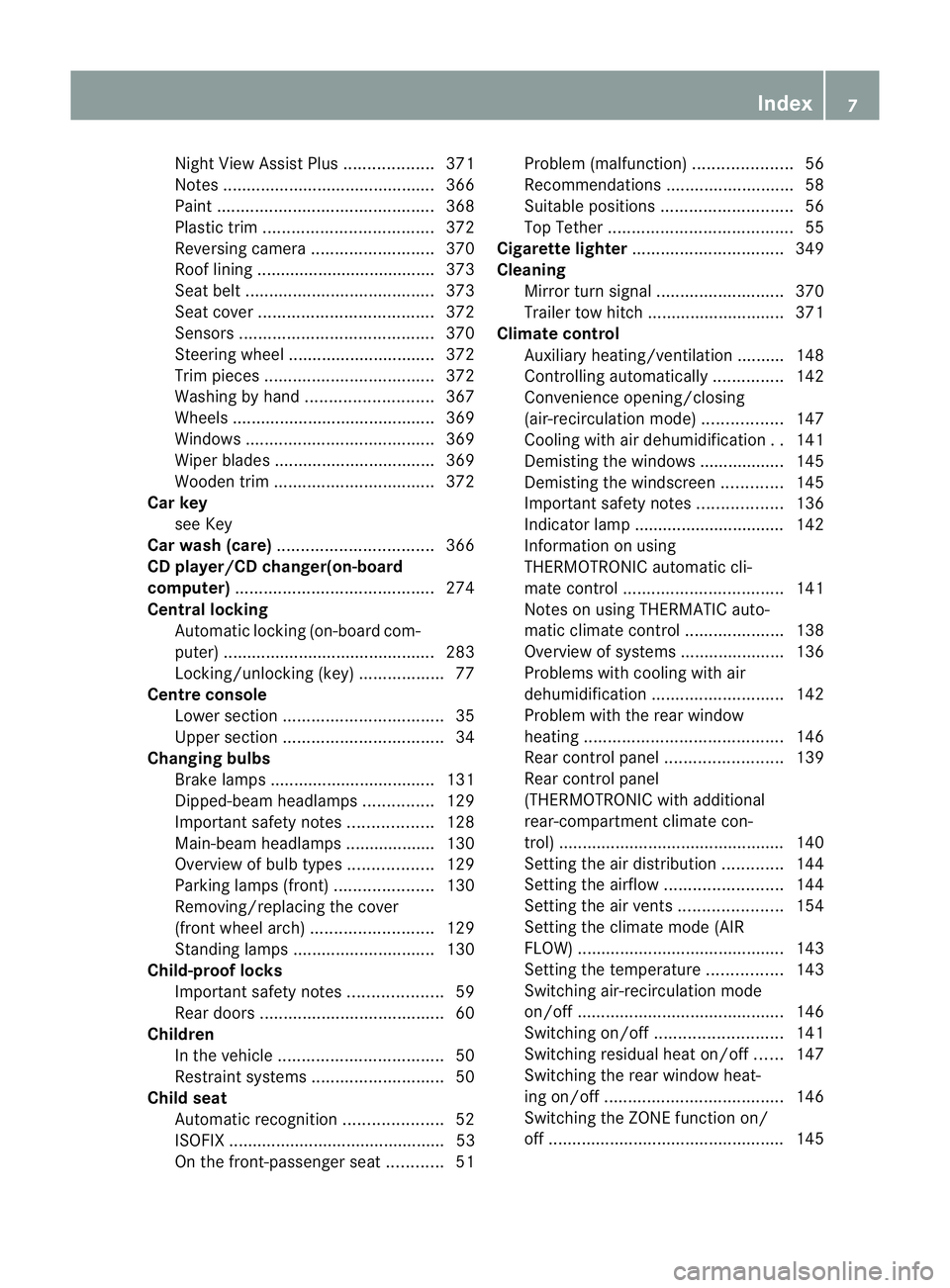
Night Vie
wAssist Plus ................... 371
Note s............................................. 366
Pa int. ............................................. 368
Pl ast ic trim .................................... 372
Revers ingc amera .......................... 370
Roo flining ...................................... 373
Seat bel t........................................ 373
Sea tcover ..................................... 372
Sensors ......................................... 370
Steering wh eel............................... 372
Tri mp ieces .................................... 372
Washing by hand ........................... 367
Wheels ........................................... 369
Windows ........................................ 369
Wi perb lades .................................. 369
Wooden trim .................................. 372
Car key
seeK ey
Car wash (care) ................................. 366
CD player /CDc hanger( on-board
computer) .......................................... 274
Central locking Automatic lockin g(on-board com-
puter) ............................................ .283
Locking/unlockin g(key ).................. 77
Centr econsole
Low er se ction .................................. 35
Uppe rsection .................................. 34
Changin gbulbs
Brake lamps ................................... 131
Dipped-bea mheadlamps ............... 129
Important safety notes ..................128
Ma in-beam headlamps ................... 130
Overview of bul btypes .................. 129
Parking lamps (front) .....................130
Removing/repl acing the cover
(fron twheel arch) .......................... 129
Standing lamps .............................. 130
Child-proof locks
Important safety notes ....................59
Rea rdoors ....................................... 60
Children
In the veh icle ................................... 50
Restraint sy stems ............................ 50
Child seat
Automatic recognitio n..................... 52
ISOFIX .............................................. 53
On the front-passenger se at............ 51Pro
blem (malfunction) ..................... 56
Rec ommend ations ........................... 58
Suit able positions ............................ 56
To pT ether ....................................... 55
Cigarette li ghter ................................ 349
Clean ing
Mirr ortur ns ignal ........................... 370
Traile rtow hitc h............................. 371
Climate control
Auxi liaryheating/ventilation ...... .... 148
Contro lling automatically ...............142
Convenience op ening/closing
(air-recirculatio nmode) ................. 147
Co oling with air dehumidificatio n..1 41
Demist ingt he windows ...... ............ 145
Demisting the windscreen .............145
Important safety notes ..................136
Indicator lamp ................................ 142
Informat ion onusing
THERMOTRONIC automatic cli-
mate control .................................. 141
Note sonu sing THERMATIC auto-
matic climate control .....................138
Overview of sy stems ...................... 136
Pro blem swithc ooling with air
dehumid ification ............................ 142
Pro blem with the rear window
heating .......................................... 146
Rea rcontrol panel ......................... 139
Rea rcontrol panel
(THERMOTRONIC with additional
rear-compartmen tclimate con-
trol) ................................................ 140
Setting the air distribution .............144
Setting the airflo w......................... 144
Setting the ai rvent s...................... 154
Setting the climate mod e(AIR
FLOW) ............................................ 143
Setting the temperature ................143
Switch inga ir-recirculation mode
on/off ............................................ 146
Switch ingo n/off ........................... 141
Switch ingr esidua lheat on/off ......147
Switch ingt he rea rwindo wheat-
ing on/of f...................................... 146
Switch ingt he ZON Efunction on/
off .................................................. 145 Index
7
Page 16 of 441
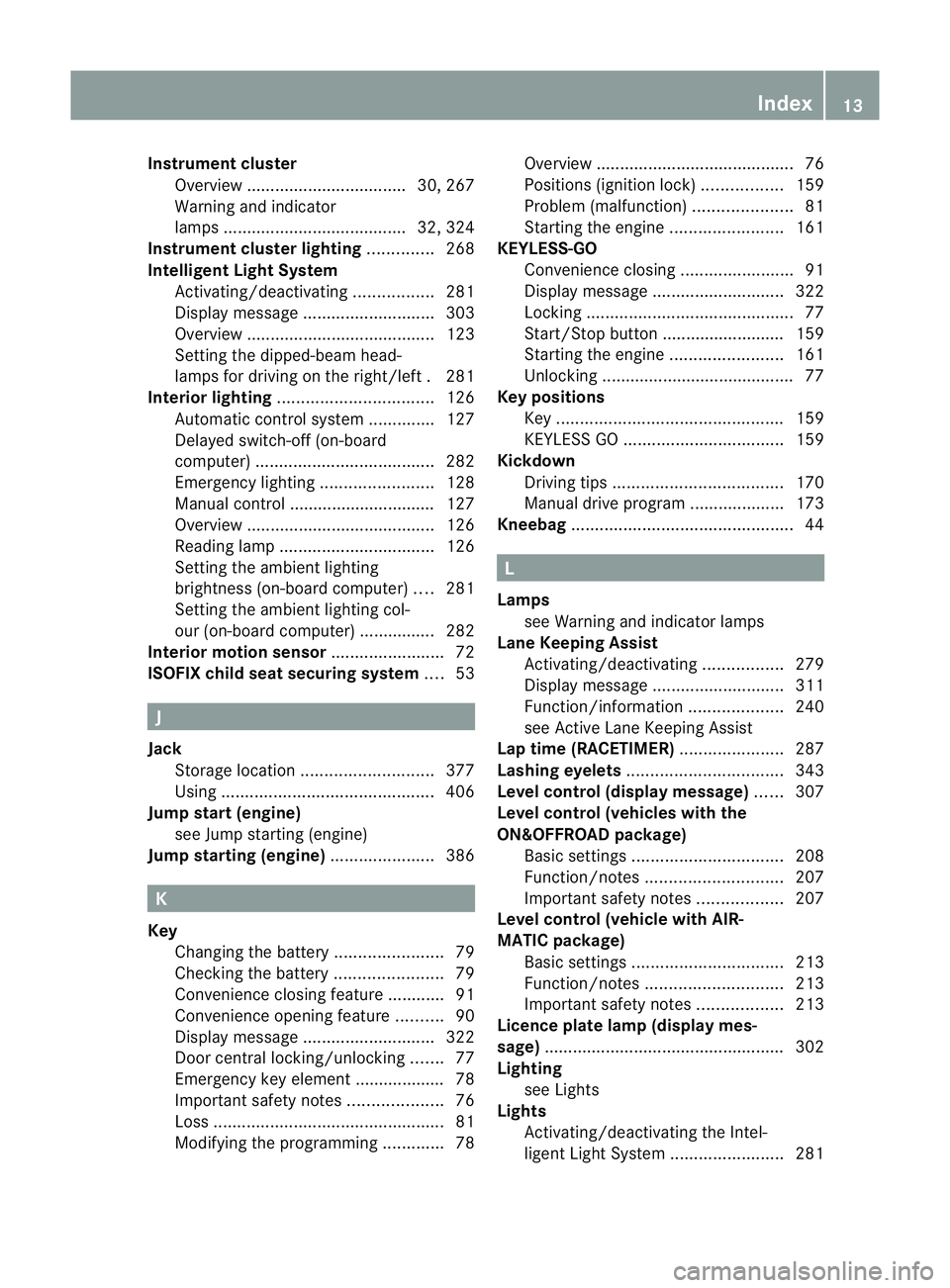
Instr
ument cluster
Overview .................................. 30 ,267
Warning and indicator
lamp s....................................... 32, 324
Instrument cluster lighting ..............268
Int elligen tLight System
Activating/deactivatin g................. 281
Display message ............................ 303
Overview ........................................ 123
Setting the di pped-beam head-
lamps for driving on the right/left .281
Int erior lighting ................................. 126
Automatic control sy stem .............. 127
Del ayed swit ch-off (on-bo ard
computer) ...................................... 282
Emergency lighting ........................128
Manual control ............................... 127
Overview ........................................ 126
Reading lamp ................................. 126
Setting the ambient lighting
bri ghtness (on-bo ardc omputer ).... 281
Setting the ambient lighting col-
ou r(on-board computer) ...... .......... 282
Interior motio nsensor ........................ 72
IS OFIX child seat securing system ....53 J
Jack Storage locatio n............................ 377
Using ............................................. 406
Jump star t(engine)
se eJ um pstarting (engine)
Jump starting (engine) ......................386 K
Key Changing the battery ....................... 79
Ch ecking the battery ....................... 79
Convenience closing feat ure. ........... 91
Convenience op ening feature ..........90
Display message ............................ 322
Doo rcentral locking/unlocking .......77
Emergency key el ement ...... ............. 78
Important safety note s.................... 76
Los s................................................. 81
Modifying the programming .............78Overview
.......................................... 76
Positions (i gnition lock) ................. 159
Pro blem (malfunction) ..................... 81
Starting the engine ........................161
KEYLES S-GO
Convenience closing ........................91
Display message ............................ 322
Locking ............................................ 77
Start/Sto pbutton ...... .................... 159
Starting the engine ........................161
Unlockin g......................................... 77
Ke yp ositions
Key ................................................ 159
KEYLESS GO .................................. 159
Kickdown
Driving tip s.................................... 170
Manual drive program ....................173
Kneebag ............................................... 44 L
Lamps seeW arning and indicator lamps
Lane Keepin gAssist
Activating/ deactivating ................. 279
Display message ............................ 311
Function/informatio n.................... 240
se eA ctive Lane Keeping Assist
Lap time (RACETIMER) ......................287
Lashing eyelets ................................. 343
Leve lcont rol (display message) ......307
Leve lcont rol (vehicles with the
ON&OFFROA Dpackage)
Bas ic se ttings ................................ 208
Function/notes ............................. 207
Important safety notes ..................207
Leve lcont rol (vehicle with AIR-
MATIC package) Basi csettings ................................ 213
Function/notes ............................. 213
Important safety notes ..................213
Licen ceplate lamp (display mes-
sage) ................................................... 302
Lighting seeL ights
Lights
Activating/deactivating the Intel-
ligent Light System ........................281 Index
13
Page 49 of 441
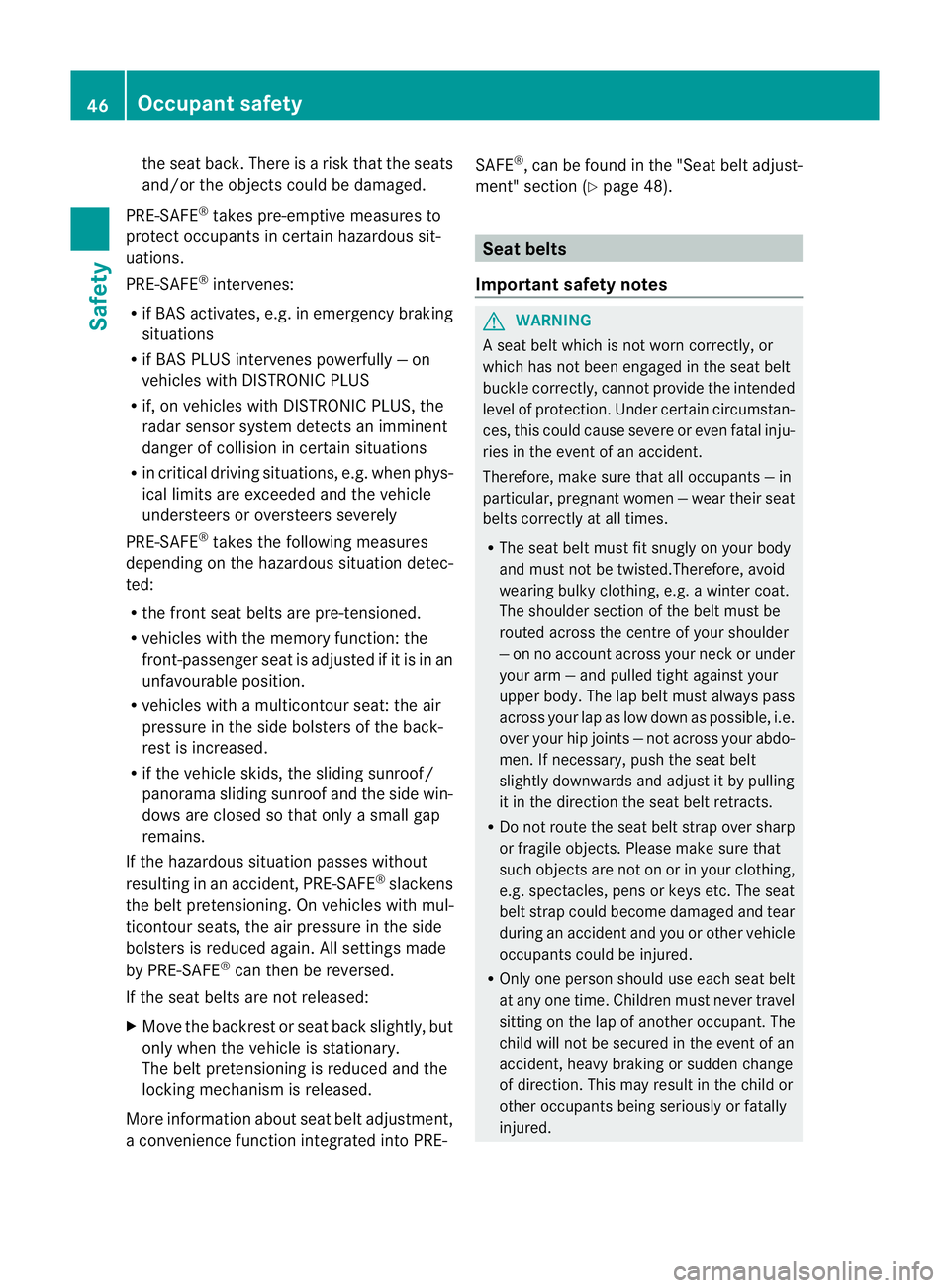
the seat back. There is
arisk thatthe seats
and/or the objec ts could be damaged.
PRE-SAFE ®
takes pre-emptive measures to
protect occupants in certain hazardous sit-
uations.
PRE-SAFE ®
intervenes:
R if BAS activates, e.g. in emergency braking
situations
R if BAS PLUS intervenes powerfull y—on
vehicles wit hDISTRONIC PLUS
R if, on vehicles with DISTRONIC PLUS, the
radar sensor system detects an imminent
dang er of collision in cer tain situations
R in critical drivin gsituations, e.g. when phys-
ical limits are exceeded and the vehicle
understeers or oversteers severely
PRE-SAFE ®
takes the following measures
depending on the hazardous situation detec-
ted:
R the front seat belts are pre-tensioned.
R vehicles with the memor yfunction: the
front-passenger seat is adjusted if it is in an
unfavourable position.
R vehicles with amulticontour seat: the air
pressure in the side bolsters of the back-
rest is increased.
R if the vehicle skids ,the slidin gsunroof/
panorama sliding sunroof and the side win-
dows are closed so that only asmall gap
remains.
If th ehazardous situation passe swithout
resulting in an accident ,PRE-SAFE ®
slackens
the belt pretensioning. On vehicles with mul-
ticontour seats ,the air pressur einthe side
bolster sisreduced again. All settings made
by PRE- SAFE®
can the nbereversed.
If the seat belts are not released:
X Move the backrest or seat back slightly, but
only when the vehicle is stationary.
The belt pretensioning is reduced and the
locki ng mech anism is released.
More information about seat belt adjustment,
ac onvenien ce function integ rated into PRE- SAFE
®
,c an be found in the "Seat belt adjust-
ment "section (Y page 48). Seat belts
Important safety notes G
WARNING
As eat belt which is not worn correctly, or
which has not been engaged in the seat belt
buckle correctly, can notp rovide th eintended
level of protection. Under certain circumstan-
ces, this could cause severe or even fatal inju-
ries in the event of an accident.
Therefore, make sure that all occupants —in
particular ,pregnant women —wear their seat
belts cor rectly at all times.
R Th es eat belt must fit snugly on your body
and must not be twisted.Therefore, avoid
wearing bulky clothing, e.g. awinter coat.
The shoulder section of the belt must be
routed across the centre of your shoulder
—onnoa ccount acros syour nec korunder
your arm —and pulled tight against your
uppe rbody. The lap belt must always pass
across your lap as low down as possible, i.e.
over your hip join ts—n ot across your abdo-
men .Ifn ecessary, push the seat belt
slightly downwards and adjust it by pulling
it in the direction the seat belt retracts.
R Do not rout ethe seat belt strap over sharp
or fragile objec ts.P lease make sure that
such object sare not on or in your clothing,
e.g .spectacles, pens or keys etc. The seat
belt strap could become damaged and tear
durin gana ccident and you or other vehicle
occupants coul dbeinjured.
R Only one person should use each sea tbelt
at any one time. Children must never travel
sittin gont he lap of another occupan t.The
child will not be secured in the even tofan
accident ,heavy braking or sudden change
of direction .This ma yresult in the child or
other occupants being seriously or fatally
injured. 46
Occupant safetySafety
Page 53 of 441
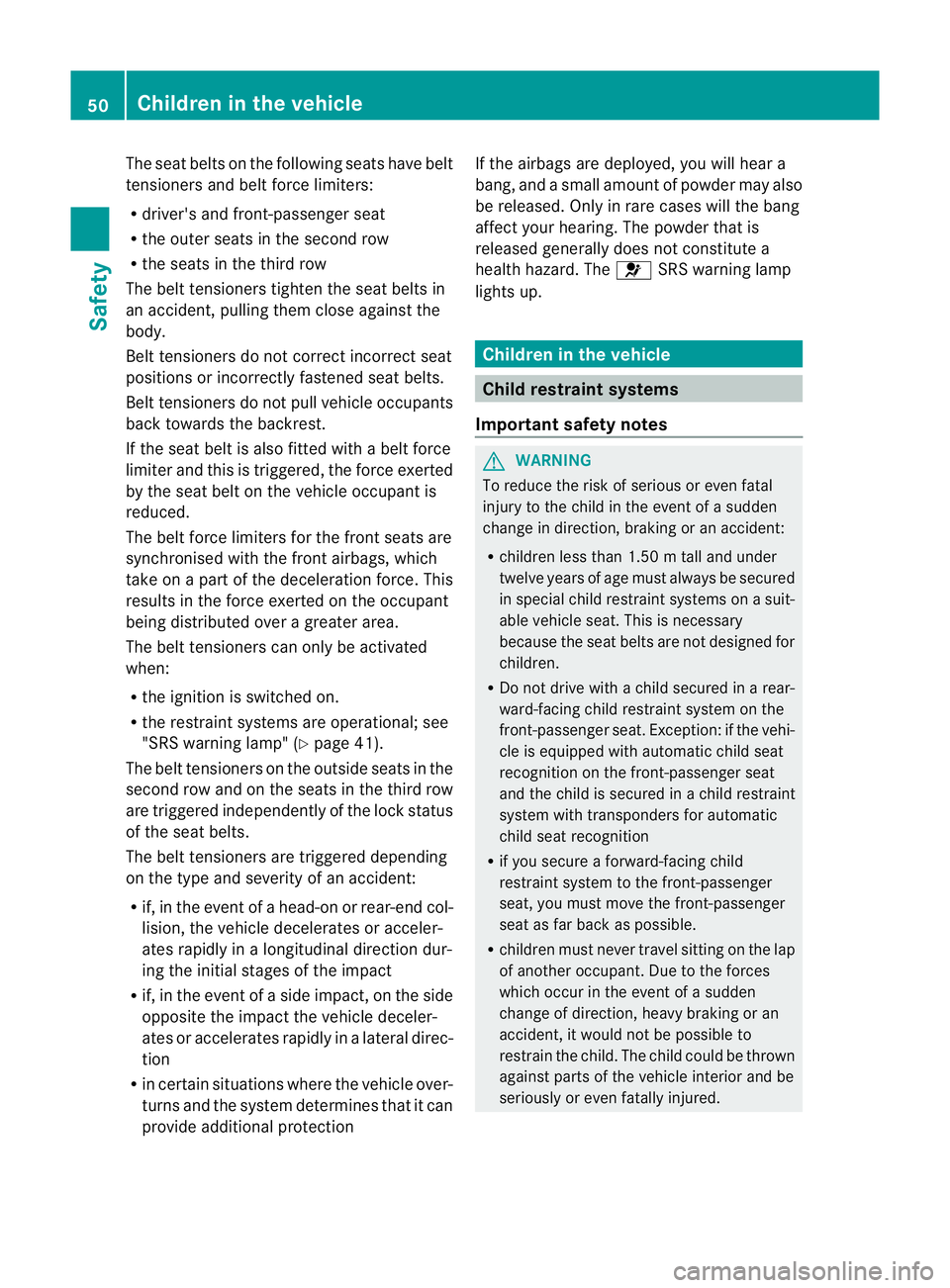
The seat belts on the following seats have belt
tensioner
sand bel tforc elimiters:
R driver's and front-passenger seat
R the outer seats in the second row
R the seats in the third row
The belt tensioners tighten the seat belts in
an accident ,pulling them close against the
body.
Belt tensioners do not correc tincorrect seat
positions or incorrectly fastened sea tbelts.
Belt tensioners do not pull vehicle occupants
back towards the backrest.
If the seat belt is also fit tedw ithabelt force
limiter and this is triggered, the force exer ted
by the seat belt on the vehicle occupant is
reduced.
The belt force limiters for the fron tseats are
synchronised with the fron tairbags, which
tak eona part of the deceleration force. This
result sinthe force exerted on the occupant
being distributed over agrea tera rea.
Th eb elt tensioners can only be activa ted
when:
R the ignition is switched on.
R the restraint system sare opera tional; see
"SR Swarnin glamp" (Y page 41).
The belt tensioners on the outside seats in the
second row and on the seats in the thir drow
ar et riggere dindependently of the lock status
of the sea tbelts.
The belt tensioners are triggere ddepending
on the type and severity of an accident:
R if, in the even tofahead-on or rear-end col-
lision, the vehicle decelerates or acceler-
ates rapidly in alongitudinal direction dur-
ing the initial stages of the impact
R if, in the even tofaside impact, on the side
opposit ethe impac tthe vehicle deceler-
ates or accelerates rapidly in alateral direc-
tion
R in certain situations where the vehicle over-
turns and the system determines that it can
provide additional protection If the airbags are deplo
yed,you will hear a
bang, and asmall amount of powder may also
be released. Only in rare cases will th ebang
affect your hearing. The powde rthat is
released generally does not constitute a
healt hhazard. The 6SRS warning lamp
lights up. Children in the vehicle
Child restraint systems
Important safety notes G
WARNING
To reduce the risk of serious or even fatal
injury to the child in the event of asudden
change in direction, braking or an accident:
R children less than 1.50 mtall and under
twelve years of age must always be secured
in special child restraint systems on asuit-
able vehicle seat. This is necessary
because the seat belts are not designed for
children.
R Do not drive with achild secured in arear-
ward-facing child restraint system on the
front-passenger seat. Exception: if the vehi-
cle is equipped with automatic child seat
recognition on the front-passenger seat
and the child is secured in achild restraint
system with transponders for automatic
chil dseat recognition
R if you secur eaforward-facing child
restraint system to the front-passenger
seat, you must mov ethe front-passenger
seat as fa rback as possible.
R children must never travel sitting on the lap
of another occupant. Due to the forces
which occur in the event of asudden
change of direction, heavy braking or an
accident, it would not be possible to
restrain the child. The child could be thrown
against parts of the vehicle interior and be
seriously or even fatally injured. 50
Children in the vehicleSafety
Page 55 of 441
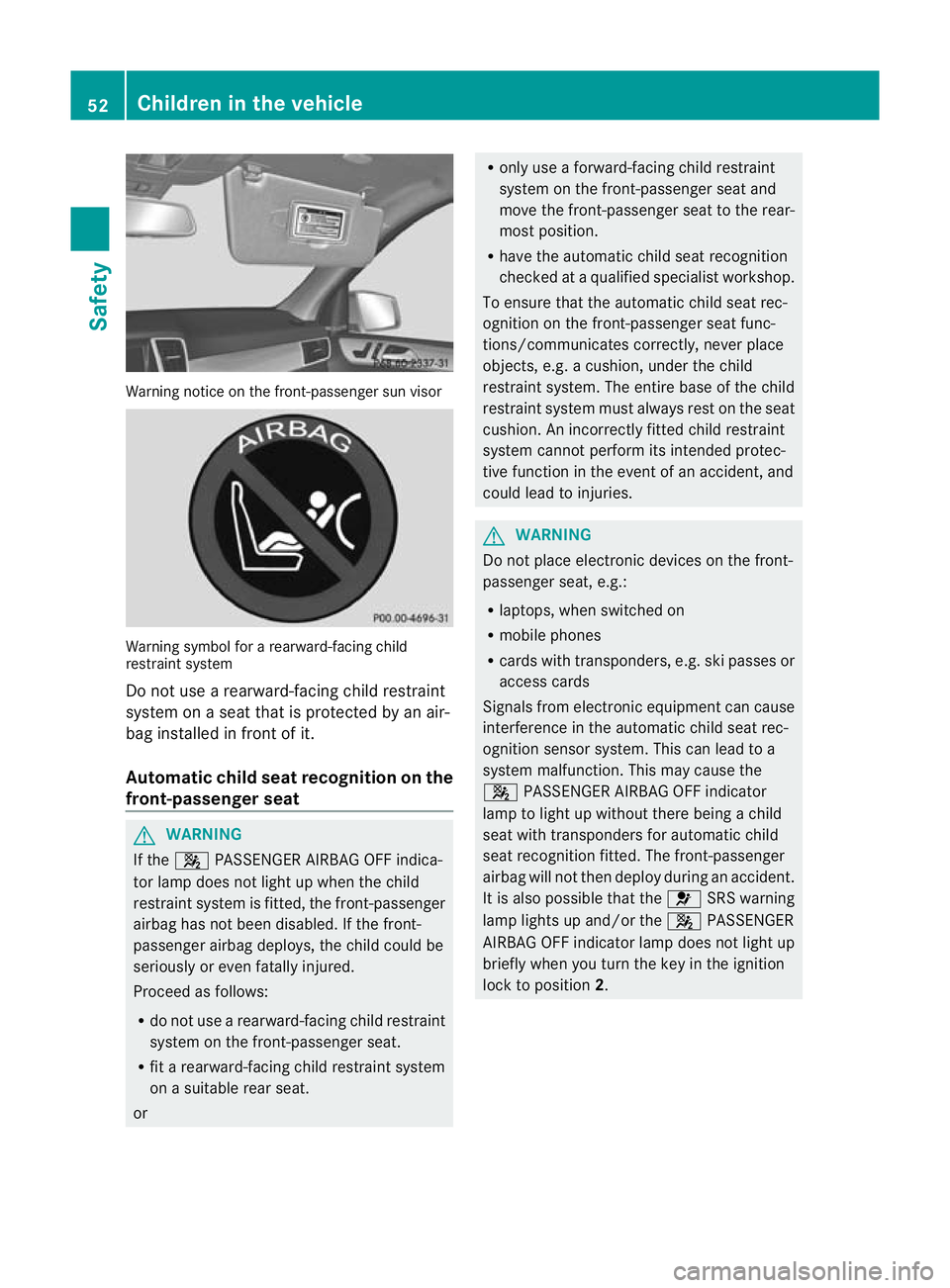
Warning notice on the front-passenger sun visor
Warning symbol for
arearward-facin gchild
rest raint system
Do not use arearward-facin gchild rest raint
system on aseat that is protected by an air-
bag installed in fron tofit.
Automatic chil dseat recognition on the
front-passenger seat G
WARNING
If the 4 PASSENGE RAIRBA GO FF indica-
tor lamp does not light up whe nthe child
restraint system is fitted, the fr ont-passenger
airbag has not been disabled. If the fr ont-
pa ssenger airbag deploys, the chil dcould be
seriou slyor even fatally injured.
Proceed as follows:
R do not use arearward-facin gchild restraint
system on the fr ont-passengers eat.
R fit arearward-facing child restraint system
on asuitable rear seat.
or R
only use aforward-facing child rest raint
system on the front-passenger seat and
move the front-passenger seat to the rear-
most position.
R have the automatic child seat recognition
checked at aqualified specialist workshop.
To ensure that the automatic child seat rec-
ognition on the front-passenger seat func-
tions/communicates correctly, never place
objects, e.g. acushion, under the child
restraint system. The entire base of the child
restraint system must alway srest on the seat
cushion. An incorrec tlyf itted child restraint
system cannot perfor mits intended protec-
tive function in the event of an accident, and
could lead to injuries. G
WARNING
Do not place electronic devices on the front-
passenger seat, e.g.:
R laptops, when switched on
R mobile phones
R cards with transponders, e.g. ski passes or
access cards
Signals from electronic equipment can cause
interference in the automatic child seat rec-
ognition sensor system. Thi scan lead to a
system malfunc tion. This may cause the
4 PASSENGER AIRBA GOFF indicator
lamp to light up without there being achild
seat with transponder sfor automatic child
seat recognition fit ted. The front-passenger
airba gwill not then deploy during an accident.
It is also possible that the 6SRS warning
lamp lights up and/or the 4PASSENGER
AIRB AGOFF indicator lam pdoes not light up
briefly when you tur nthe key in the ignition
lock to position 2.52
Children in th
evehicleSafety
Page 56 of 441
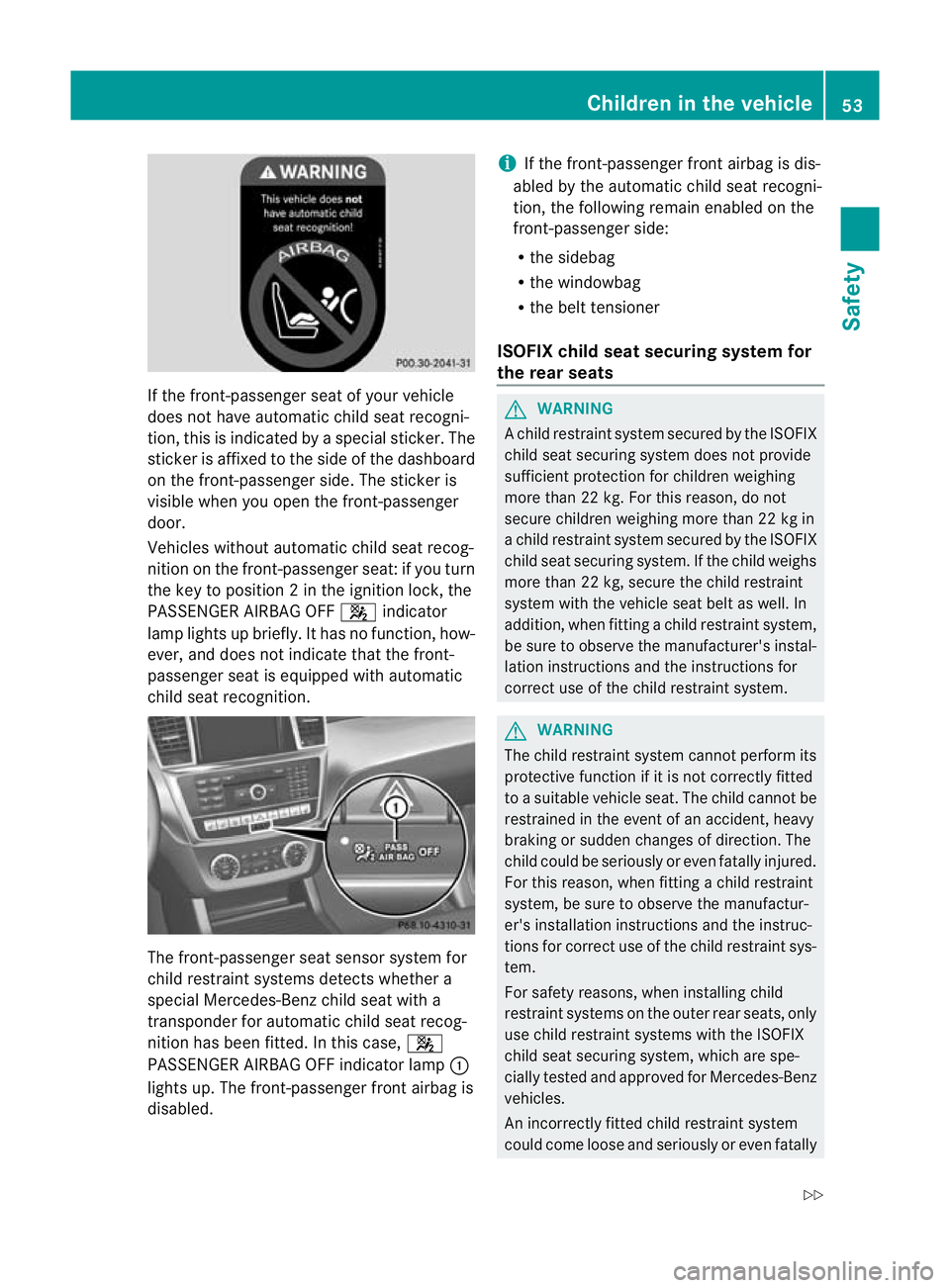
If th
efront-passenger seat of yo urvehicle
does no thave automatic child seat recogni-
tion, this is indicated by aspecial sticker. The
sticker is affixed to the side of the dashboard
on the front-passenger side. The sticker is
visible when you open the front-passenger
door.
Vehicles without automatic child seat recog-
nition on the front-passenger seat: if you turn
the key to position 2inthe ignition lock ,the
PAS SENG ER AIRBAG OFF 4indicator
lamp lights up briefly. It has no function, how-
ever, and doe snot indicate that the front-
passenger seat is equipped with automatic
child seat recognition. The front-passenger seat sensor system for
child restraint system
sdetect swhether a
special Mercedes-Ben zchild seat with a
transpo nder for automatic child seat recog-
nition has been fitted. In this case, 4
PASSENGER AIRBA GOFF indicato rlamp :
lights up. The front-passenger front airbag is
disabled. i
If the front-passenger front airbag is dis-
abled by the automatic child seat recogni-
tion, the following remain enabled on the
front-passenger side:
R the sidebag
R the windowbag
R the belt tensioner
ISOFI Xchilds eat securing system for
the rear seats G
WARNING
Ac hild restraint system secured by the ISOFIX
chil dseat securing system does not provide
sufficien tprotection for children weighing
more than 22 kg. For this reason, do not
secure children weighing more than 22 kg in
ac hild restraint system secured by the ISOFIX
chil dseat securing system. If the child weighs
mor ethan 22 kg, secur ethe chil drestraint
system with the vehicle seat belt as well. In
addition ,when fittin gachild restraint system,
be sur etoobservethe manufacturer' sinstal-
latio ninstructions and the instructions for
correct use of the child restraint system. G
WARNING
The child restraint system cannot perform its
protective function if it is not correctly fitted
to as uitable vehicle seat. The child cannot be
restrained in the event of an accident, heavy
braking or sudde nchanges of direction. The
chil dcould be seriously or even fatally injured.
For this reason, when fittin gachild restraint
system ,besure to observe the manufactur-
er's installatio ninstructions and the instruc-
tions for correct use of the child restraint sys-
tem.
For safety reasons, whe ninstalling child
restraint systems on the outer rear seats, only
use child restraint systems with the ISOFIX
child sea tsecuring system, which are spe-
ciall ytested and approved for Mercedes-Benz
vehicles.
An incorrectly fitted child restraint system
could com eloose and seriously or even fatally Children in the vehicle
53Safety
Z
Page 62 of 441
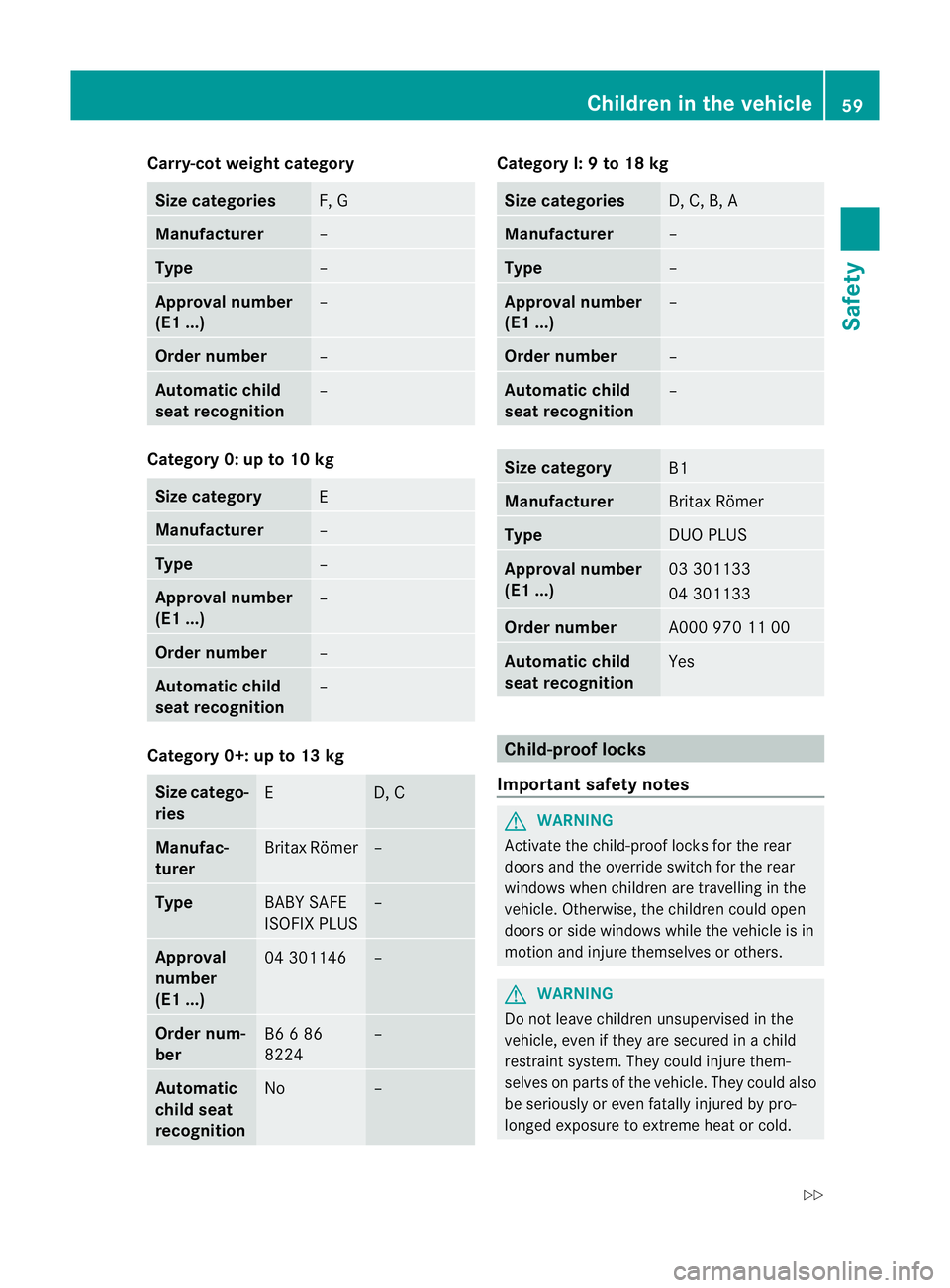
Carry-cot weight category
Size categories
F, G
Manufacturer
–
Type
–
Approva
lnumber
(E1 ...) –
Order number
–
Automatic child
seat recognition
–
Category 0: up to 10 kg
Size category
E
Manufacturer
–
Type
–
Approval number
(E1 ...)
–
Order number
–
Automatic child
seat recognition
–
Category 0+
:upto13kg Siz
ecatego-
ries E D, C
Manufac-
turer
Brita
xRömer –
Type
BABY SAFE
ISOFIX PLUS –
Approval
number
(E1 ...)
04 301146 –
Order num-
ber
B6
686
8224 –
Automatic
chil
dseat
recognition No – Categor
yI:9to18kg Siz
ec ategories D, C, B, A
Manufacturer
–
Type
–
Approval number
(E1 ...)
–
Order number
–
Automatic child
seat recognition
–
Si
ze category B1
Manufacturer
Britax Römer
Type
DU
OP LUS Approval number
(E
1. ..) 03 301133
04 301133
Order number
A000 97
01100 Automatic child
seat recognition
Yes
Child-proof locks
Important safety notes G
WARNING
Activate the child-proof lock sfor th erear
door sand the override switch for the rear
windows whe nchildr en are travel ling in the
vehicle. Otherwise, the children could open
doors or sid ewindows while the vehicle is in
motion and injur ethemselves or others. G
WARNING
Do not leave children unsu pervis edin the
vehicle, even if they are secured in achild
restraint system .They coul dinjure them-
selve sonp arts of the vehicle. They could also
be seriousl yoreven fata llyi njured by pro-
longed exposure to extreme hea torcold. Children in the vehicle
59Safety
Z
Page 63 of 441
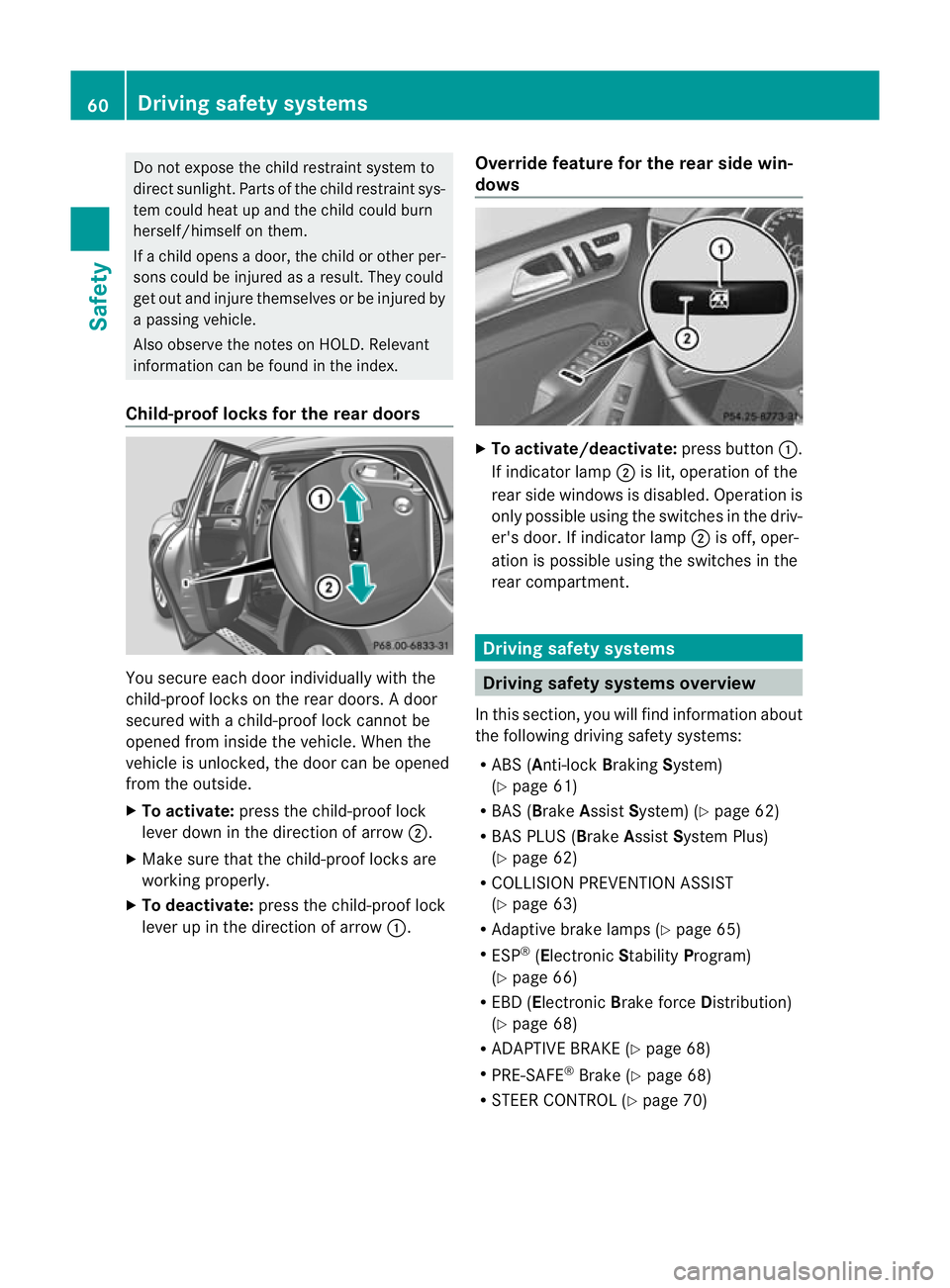
Do not expose the child restraint system to
direct sunlight. Parts of the child restraint sys-
tem could heat up and the child could burn
herself/h imselfonthem.
If ac hild opens adoor, th echild or other per-
sons coul dbeinjured as aresult. They could
get out and injure themselves or be injured by
ap assing vehicle.
Also observe the notes on HOLD .Relevant
information can be foun dinthe index.
Child- proof locks for the rear doors You secure each door individually with the
child-proof locks on the rear doors.
Adoor
secured with achild-proof lock can notbe
opened from inside the vehicle. When the
vehicle is unlocked, the door can be opened
from the outside.
X To activate: press the child-proof lock
leve rdown in the direction of arrow ;.
X Make sure that the child-proof lock sare
workin gproperly.
X To deactivate: press thechild-proof lock
lever up in the direction of arrow :.Overrid
efeature for the rear side win-
dows X
To activate/deactivate: press button:.
If indicator lamp ;is lit, operation of the
rear side windows is disabled. Operation is
only possible using the switches in the driv-
er' sd oor. If indicator lamp ;is off ,oper-
ation is possible using the switches in the
rear compart ment. Driving safety systems
Driving safety systems overview
In this section, you will find information about
the following driving safety systems:
R ABS (Anti-lock BrakingSystem)
(Y pag e61)
R BAS (Brake AssistSystem) (Y page62)
R BAS PLUS ( BrakeAssist System Plus)
(Y pag e62)
R COLLISION PREVENTION ASSIST
(Y pag e63)
R Adaptive brak elamps (Y page 65)
R ESP ®
(Electronic StabilityProgram)
(Y page 66)
R EBD ( Electronic Brake force Distribution)
(Y page 68)
R ADAPTIVE BRAKE (Y page 68)
R PRE-SAFE ®
Brake (Y page 68)
R STEE RCONTROL (Y page 70)60
Driving safety systemsSafety
Page 79 of 441
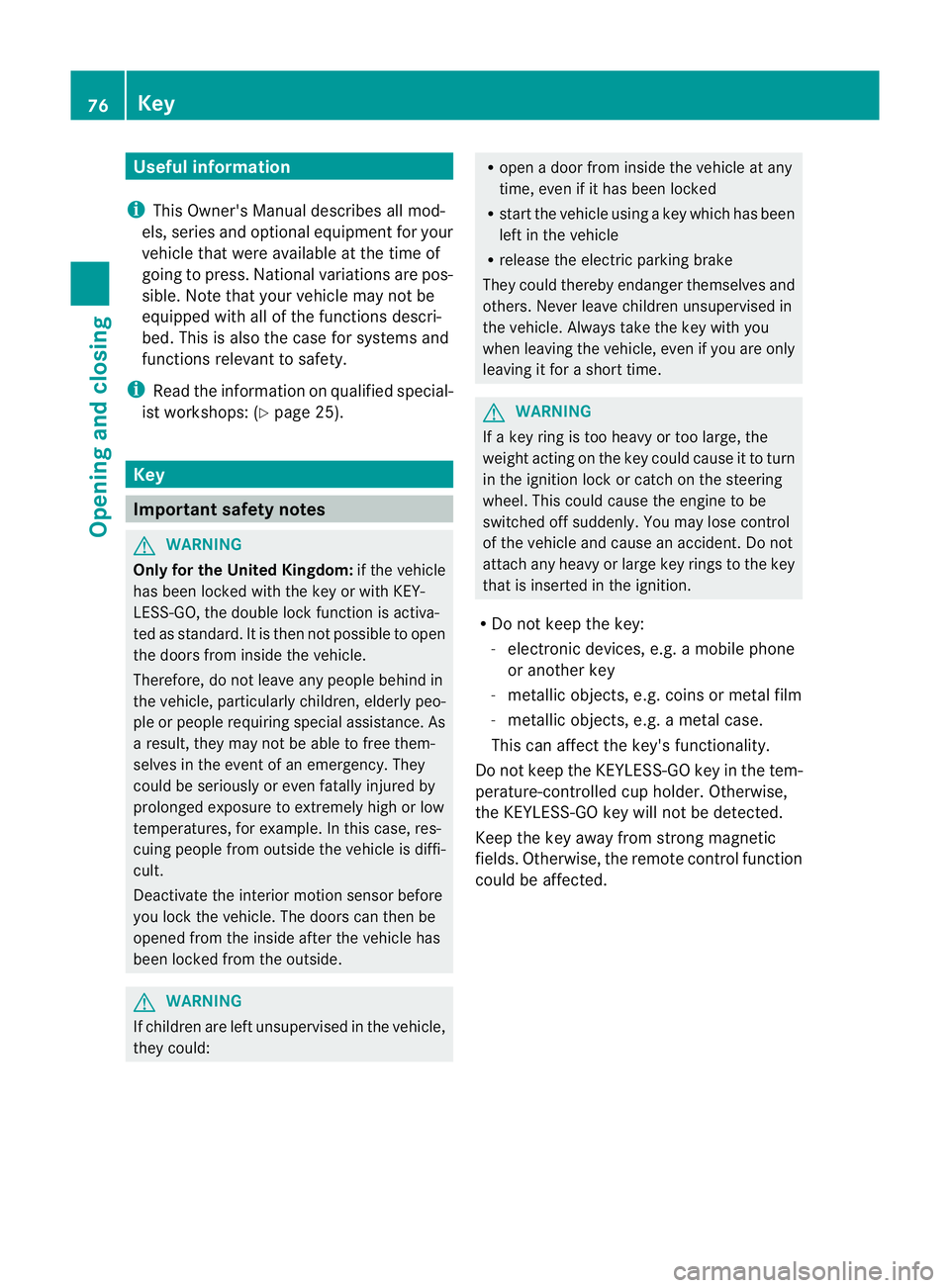
Usefu
linfor mati on
i This Owner's Manual describes all mod-
els, series and optional equipment for your
vehicle that were available at the time of
going to press. National variation sare pos-
sible. Note that your vehicl emay not be
equippe dwith all of the function sdescri-
bed. This is also the case for system sand
functions relevant to safety.
i Read the information on qualified special-
ist workshops: (Y page25). Key
Impo
rtantsafety notes G
WARNING
Only for the Unite dKingdom: if the vehicle
has been locked with the key or with KEY-
LESS-GO, the double lock function is activa-
ted as standard. It is then not possible to open
the doors from inside the vehicle.
Therefore, do not leave any people behind in
the vehicle, particularly children ,elderly peo-
ple or people requirin gspecial assistance. As
ar esult, they may not be able to free them-
selves in the even tofanemergency. They
could be seriously or eve nfatally injured by
prolonged exposure to extremely high or low
temperatures, for example. In this case, res-
cuing peopl efrom outsid ethe vehicle is diffi-
cult.
Deac tivate th einterior motion sensor before
you lock the vehicle. The doors can then be
opened from the inside after the vehicl ehas
been locked from the outside. G
WARNING
If children are left unsupervised in the vehicle,
they could: R
open adoor from inside the vehicle at any
time, even if it has been locked
R star tthe vehicle usin gakey which has been
left in the vehicle
R release the electric parking brake
They could thereby endanger themselves and
others. Never leave children unsupervised in
the vehicle. Alway stake the key with you
when leaving the vehicle, even if you are only
leaving it for ashort time. G
WARNING
If ak ey rin gistoo heavy or too large, the
weight actin gonthe key coul dcause it to turn
in the ignition lock or catc honthe steering
wheel. This coul dcause the engine to be
switched off suddenly. You may lose control
of the vehicle and cause an accident. Do not
attac hany heavy or large key rings to the key
that is inserted in the ignition.
R Do not keep the key:
-electronic devices, e.g. amobile phone
or anothe rkey
- metallic objects, e.g. coins or metal film
- metallic objects, e.g. ametal case.
This can affect the key' sfunctionality.
Do not keep the KEYLESS-GO key in the tem-
perature-controlled cup holder. Otherwise,
the KEYLESS-GO key will not be detected.
Keep the key away from strong magnetic
fields. Otherwise, the remot econtrol function
coul dbea ffected. 76
KeyOpenin
gand closing
Page 82 of 441
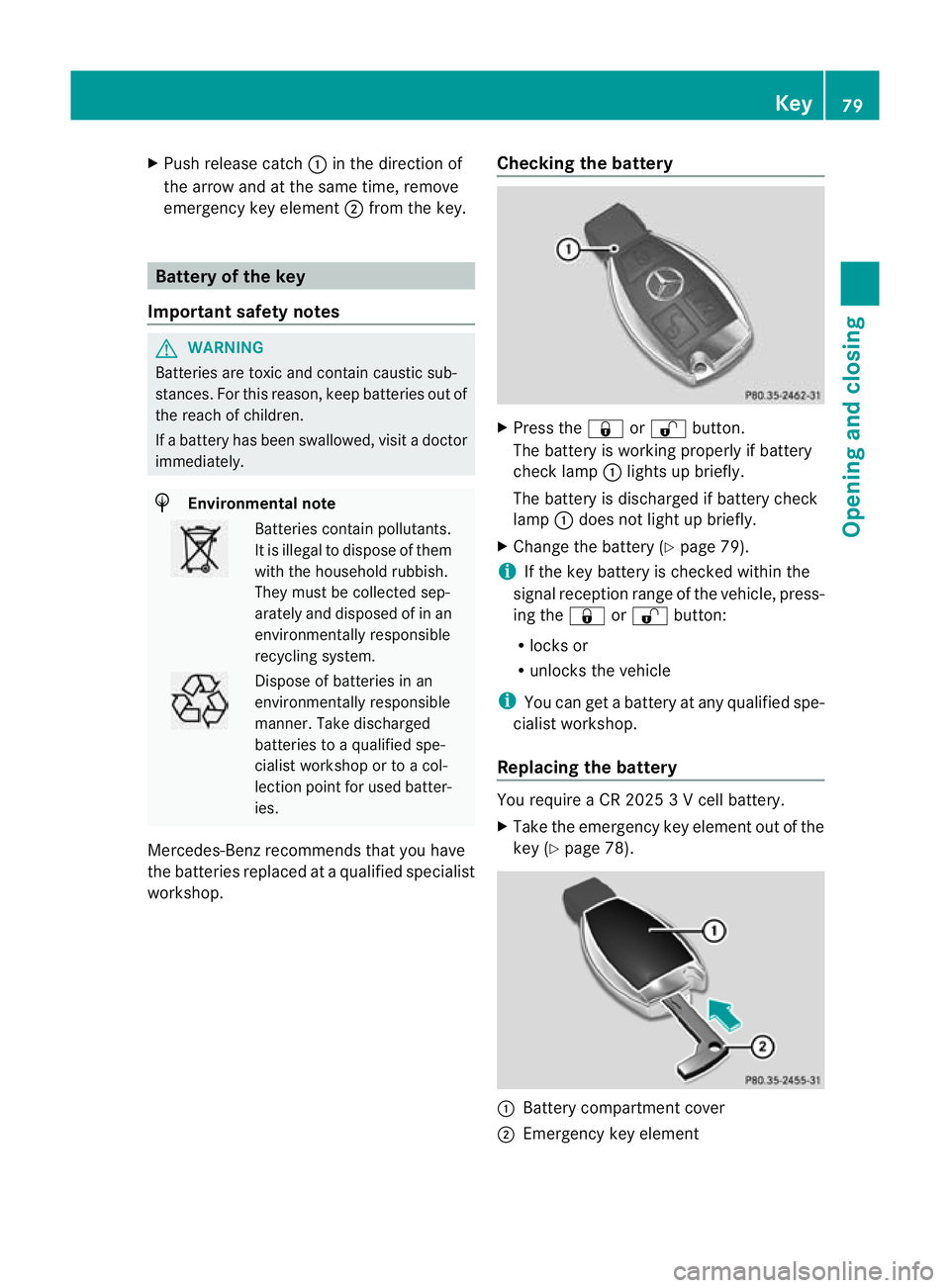
X
Push release cat ch: in the direction of
the arrow and at the same time, remove
emergenc ykey element ;from the key. Ba
ttery of the key
Important safety notes G
WARNING
Batteries are toxic and contain caustic sub-
stances. For this reason, keep batteries out of
the reach of children.
If ab attery has been swallowed, visit adoctor
immediately. H
Environment
alnote Bat
teri es contain pollutants.
It is illegal to dispose of them
with the household rubbish.
They must be collec teds ep-
arately and disposed of in an
environmen tally responsible
recycling system. Dispose of batteries in an
environmentally responsible
manner
.Take discharged
batteries to aqualified spe-
cialist workshop or to acol-
lection point for used batter-
ies.
Mercedes-Benz recommends that you have
the batteries replaced at aqualified specialist
workshop. Checking the battery X
Press the &or% button.
The battery is working properly if battery
check lamp :lights up briefly.
The battery is discharge difbattery check
lamp :does not light up briefly.
X Change the battery (Y page 79).
i If the key battery is checked within the
signal reception range of the vehicle, press-
ing the &or% button:
R locks or
R unlocks the vehicle
i You can get abattery at any qualified spe-
cialist workshop.
Replacing the battery You require
aCR20253Vc ell battery.
X Take the emergenc ykey elemen tout of the
key (Y page 78). :
Battery compartment cover
; Emergency key element Key
79Openin gand closing Z